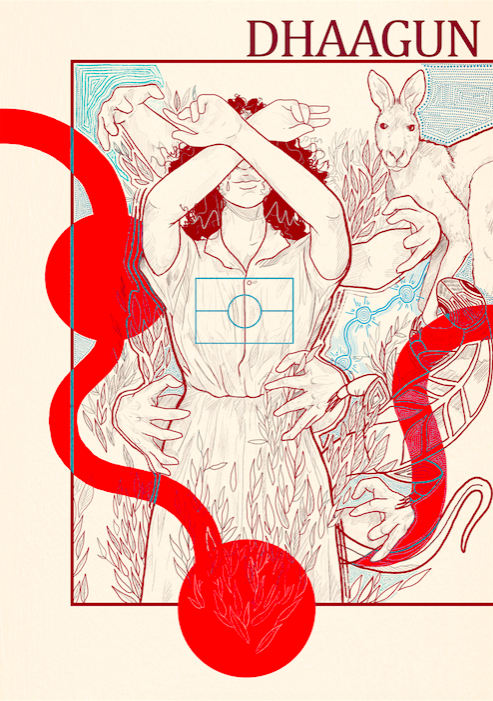Born 1993 in Moruya, Australia Lives and works in Naarm / Melbourne, Australia Wiradjuri and Ngiyampaa
Across illustrations, zines and comics, Charlotte Allingham creates graphic works deeply reflective of her thoughts connecting to culture, identity, the broader impacts of colonisation and how one can activate change.
At the centre of the frame, Allingham’s works often place Indigenous women within landscapes, with animals, at front-line protests or in intimate conversations. These deeply personal scenes present clear definitions of self-empowerment and freedom, offering guidance, suggesting actions and philosophies of how histories can be re-read, and how the individual’s personal aches can be shared as a moment of relief and acknowledgement. The works in this installation were commissioned to respond to the seven themes of NIRIN. Using only Wiradjuri words, these works beautifully unfold the way these themes are interrelated and centred in an interconnected way of being. DHAAGUN | My ancestors, roots steaming from the soles of my feet, deep deep. red dirt. BAGARAY-BANG | Allowing my heart to feel the wind, the way it whispers through my pain, I hear the broken pieces coming together. one piece. two pieces. YIRAWY–DHURAY | My body needs. My soul needs. Connect. Connect. I hear you. GURRAY | In this I will come through, powerful and brave. Through this I will become. Transcend this. Transform aspects to grow another. NGAWAAL-GUYUNGAN | Resist. My voice gives home to my ideas, to stand against the colony, and will not falter, for I am who I am. My father’s daughter. the design of my ancestors. BILA | The river that flows through my country, like the blood. Keep me surviving. I hear you, just as my grandmother does from her house. I am far, but you are here. I hear you. Charlotte Allingham is a 26-year-old Wiradjuri, Ngiyampaa woman from New South Wales, with family ties to Condobolin and Ivanhoe. She currently lives in Naarm, creating Illustrations about her culture and identity, and the impacts of colonisation. Commissioned by the Biennale of Sydney with generous support from Aesop and the Copyright Agency’s Cultural Fund
